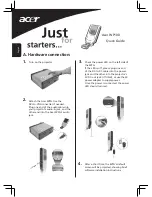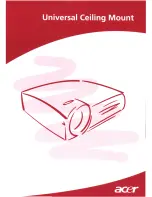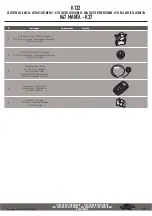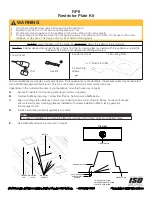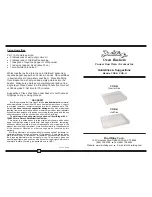
Page 2
CAUTION! DO NOT LOOK DIRECTLY AT THESE LEDS WHILE THEY ARE ON.
MOMENTARY BLINDNESS AND/OR EYE DAMAGE COULD RESULT!
IMPORTANT WARNING!
IMPORTANT! The lightbar should be a minimum of 16" from
any radio antennas!
Permanent Mounting:
This mounting style requires
removal of the headliner. There
may be a roof support member that
runs from the drivers to the
passengers side of the vehicle.
Do
not drill through this member
.
Caution: Permanent mounting of
this product will require drilling.
It is absolutely necessary to
make sure that no other vehicle
components could be damaged
by this process. Check both
sides of the mounting surface before starting. If damage is likely,
select a different mounting location.
1.
When the mounting location has been determined, slide the 2
mounting bolts into the lightbar extrusion, one bolt in each track.
Position these bolts so that they are at opposite ends of the extrusion
and as far appart as possible.
2.
Place the lightbar on the vehicle in its proposed mounting location.
Mark the location of the 2 mounting bolts onto the mounting surface.
Also, mark the area for the wire passage hole. This hole should be
located directly below where the wires exit the extrusion.
3.
Remove the lightbar and drill two, 5/16” dia. mounting holes and a 5/
16” dia. wire passage hole. De-burr all three holes and install a
rubber grommet (customer supplied) into the wire passage hole.
4.
Route the wires through the grommet and to the necessary switches
and power source as shown in the diagram below.
5.
Secure the Responder® to the vehicle using the hardware provided.
From the underside of the mounting surface, apply RTV around each
mounting hole and the grommeted wire passage hole to prevent
water from entering these openings.
Remove
one end
cap
3/8-16
HEX NUT
3/8" SPLIT
LOCK WASHER
3/8" FLAT
WASHER
3/8-16 X 1-1/4"
STEP BOLT
Wiring:
WARNING! All customer supplied wires that connect to the positive
terminal of the battery must be sized to supply at least 125% of the
maximum operating current and FUSED at the battery to carry the
load. DO NOT USE CIRCUIT BREAKERS WITH THIS PRODUCT!
Scan-Lock™:
TO CHANGE PATTERNS:
To cycle forward to the next pattern
apply
+VBAT
to the Scan-Lock wire
(or switch)
for less than 1 second and
release.
To cycle back to the previous pattern
apply
+VBAT
to Scan-
Lock™ wire for over 1 second and release.
TO CHANGE THE DEFAULT PATTERN:
When the desired pattern is
displayed, allow it to run for more than 5 seconds. The lighthead will now
display this pattern when initially activated.
TO RESTORE THE FACTORY DEFAULT PATTERN:
With power off,
apply
+VBAT
to the Scan-Lock™ wire
(or switch)
. While continuing to
apply power to Scan-Lock turn lighthead(s) on. The factory default pattern
will be displayed.
A Normally Open momentary switch can be used to control Scan-
Lock. Refer to the Pattern List below for pattern information.
Low Power:
Note: Low Power is recommended for nighttime use.
Latching Mode:
By ap12V to the VIOLET wire for less than 1 sec-
ond, the lightbar is “latched” into low power. The unit must be turned off
and then back on to restore normal high power operation. A Normally
Open Momentary switch is best for Latching Mode.
Level Mode:
Ap12V to the VIOLET wire for more than 1 second
holds the lightbar in low power mode until voltage is removed. A toggle
switch is best for Latching Mode.
It is the responsibility of the installation technician to make sure that
the installation and operation of this product will not interfere with or
compromise the operation or efficiency of any vehicle equipment!
Before returning the vehicle to active service, visually confirm the
proper operation of this product, as well as all vehicle components/
equipment.
1.
SignalAlert™75 PH-1
2.
SignalAlert™75 PH-2
3.
CometFlash®75 PH-1
4.
CometFlash®75 PH-2
5.
DoubleFlash 75 PH-1
6.
DoubleFlash 75 PH-2
7.
SingleFlash 75 PH-1
8.
SingleFlash 75 PH-2
9.
ComAlert™75 PH-1
10. ComAlert™75 PH-2
11. LongBurst™75 PH-1
12. LongBurst™75 PH-2
13. PingPong™75 PH-1
14. PingPong™75 PH-2
15. SingleFlash 60
16. SingleFlash 90
17. SingleFlash 120
18. SingleFlash 300
19. DoubleFlash 150
20. ComAlert™150
21. ActionFlash 50
22. ActionFlash 150
23. ModuFlash™
24. FlimFlam
25. DoubleFlash 120
26. PingPong™120
27. TripleFlash™75
28. TripleFlash™120
29. SignalAlert™ CAL
30. ActionFlash™ 60/120
31. ActionFlash™ 120/75
32. CalScan™
33. 90 RPM
34. 118 RPM
35. 150 RPM
36. ActionScan™
BOLD = CA Title XIII Compliant
NOTE:
All fuses and switches
are customer supplied
Wiring Diagram:
WH
T (
Co
l
o
r #
1
-
Lo
w
e
r)
OR
G (
Co
l
o
r #2-
Uppe
r)
BLK
(Gr
o
u
nd
)
WH
T/VI
O
(
Scan
-
Loc
k)
1A
7.5
A
7.5
A
(+)
Ba
tt
e
ry
(-)
VI
O
(
Lo
w
Po
w
e
r)
or
Momentary Switch =
SPST Switch =




